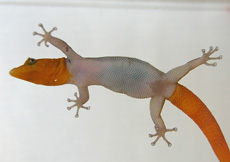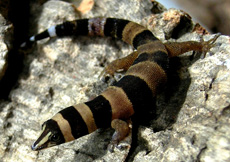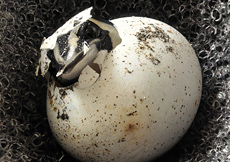Sphaerodactylus torrei
(BARBOUR, 1914)
Distribution:
Both subspecies of Sphaerodactylus torrei are located exclusively on Cuba. The range of Sphaerodactylus torrei torrei extends from Santiago de Cuba to the east of lain Playa Juraguá. While the subspecies Sphaerodactylus torrei spielmani occurs further east, from the Río Hatibonico to the Bahía Guantánamo.
Description:
The following description concerns the Nominat form, Sphaerodacylus torrei torrei. With an overall length of 8 centimeters (half this size is from the tail), Sphaerodactylus torrei is one of the largest species of the genus and because of its compact physique it is also one of the stockiest. The females are a few millimeters larger than the males. Sphaerodactylus torrei received its name in honor of the Cuban scientist Carlos de la Torre. There is a clear and distinct sexual dimorphism in this species. The head of the males is colored yellow and orange. The remaining body (top and ventral) is silver/gray. The tail of the males are an illuminating orange/red color. The females on the other hand look completely different. The females have a beige body with 10 to 11 distinct black bands from the head to the tail. On the head of the gecko are black lines which lay perpendicular to the first head band. There are always two bands on the female of this species between the front and back legs. This is a definate way to distinguish this species from the similar looking Sphaerodactylus nigropunctatus (which have three bands between the front and rear legs). The belly of the females are beige.
Juveniles of Sphaerodactylus torrei are colored exactly like the females. Once they reach about 10 months in age, the males start to show changes towards adult coloration. The scalation of the back and the head looks finely granulated. At the tail these scales become larger and overlap themselves much like tiles on a roof. Sex determination in this species is simple once you see the geckos underside. The males have a large triangular escutcheon patch between the back legs right by the tail. The round pupils of Sphaerodactylus torrei tell us that this is a diurnal species.
Habitat:
Sphaerodactylus torrei inhabits habitats that are anywhere from slightly damp to very moist, where they are exposed to the sun for short periods of time. The gecko can be found under dead wood and stones or behind the loose bark on trees. It seems this species is variable in where it is found because this species could be discovered 2.5 meters up in trees. Sphaerodactylus torrei is a very aggressive species. Every tree is usually inhabited by only a pair, in addition to juveniles and semiadult animals. The climate in this region is hot and damp, on average there is 1129 millimeters of precipitation during the year. The year is divided into a cool/dry phase in the winter (November until April) and a hot damp phase in the summer (May until October). The average day temperatures in the summer range from 31-32°C (88-90°F) and 24°C (75°F) at night. In winter temperatures will range around 26°C (79°F) during the day and 18°C (64°F) at night. The slowest time for rainfall is between December and February (arid) with 40 millimeters per month. In the summer two rain showers are to be expected. The first in between the months of May and June with up to 150 millimeters of precipitation in a month. The second occurs between the months of September and October where quantities of up to 200 millimeters per month can be expected.
Husbandry and Breeding:
Because of its aggressive nature Sphaerodactylus torrei should only be kept in pairs. A pair may be kept problem free in a terrarium measuring 25x50x30 centimeters. Even in a 1.6 meter long terrarium for example, two pairs could not be kept in harmony. However a species which blends in easily with the ground color, such as Sphaerodactylus notatus could work in the same terrarium. The side and back walls should be covered in cork bark which allows the geckos to retreat if they become scared. The floor of the terrarium should be a mixture of sand, peat moss, and crushed cork pieces, which always remains slightly moist and humid. Retreats should be created by using cork flats, cork branches and natural plants. A small bowl of water and crushed up cuttlefish bone completes the terrarium decoration.
The required humidity ranges between 70-80%, which can easily be achieved by misting the terrarium once daily.
The terrarium is illuminated by T5 lamps rated for daylight color which helps produce the necessary warmth of 26-28°C (79-82°F) during the day. At night the temperature lowers to around 24°C (75°F) and 18°C (64°F) in winter.
They should be fed two times a week. Small prey items such as crickets, firebrats, wax moths and their larvae may be offered. All prey items should be dusted with the approriate supplements at every feeding.
Sphaerodactylus torrei is not usually very re-productive in the wild, each pair needs a large amount of private space. Because of this it is not easy for the females to find suitable laying spots for the eggs and therefore they remain slow re-producers.
In the terrarium the females lay an egg about every 4 weeks, with usually no more than four eggs per year, laying is most typically done in summer. For better safety the eggs should be transported to an incubator. At incubation temperatures of 26-28°C (79-82°F) the young emerge around 80-90 days with an overall length of 37 millimeters. Raising this quite large Sphaerodactylus juvenile is relatively easy. They should be housed individually in small containers, with peat moss as the substrate, a trailing plant, a shallow water dish and cork pieces. Illumination of these containers may be provided by a small compact lamp rated for daylight color. For feeding they are offered micro crickets, firebrats, fruit flies, small wax moth larvae and springtails. You must be careful with the juveniles, as the males do not start to show their colors until about 10 months of age.
Sphaerodactylus torrei is easily one of the most beautiful representatives of its genus. In the morning and in the early evening hours the attentive hunters roam the tank which allows them to be observed at the same time. Because of their robust nature they are a good gecko for beginners, however due to their slow reproductive rate, they are still rare in the hobby.












